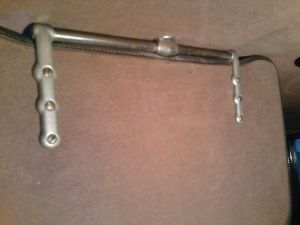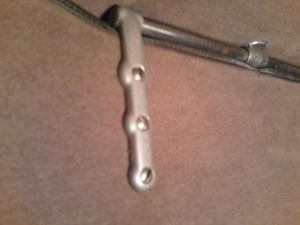- Home
- About Us
- Join/Renew
- Member Benefits
- Member Pages
- Log In
- Help
- Museum Store
David, if this is the one from e-bay a few weeks ago, I checked it then and it did fit 31-33 Pierce, but… truck only. I think Ernie Follis is the only owner of this type truck? I will recheck my delco books and get back to you. Karl
Type one parts photographed AND itemized for the chrome shop. Note again… all the interior parts on my 1930 Model C, earliest vin. number known, are nickel and not chrome! Sid, I will dig the type 2 parts out again and photograph them and get you measurements of the boards on Saturday. Karl
Chris, looks like we were getting the last info together, minutes apart. I did get one more piece of info to share: the “holes”” for the type 2 brackets have been located on the back side of the roof bow on 2 1930s. So unless someone else tells us they have them on the front of the bow this must be the location of the “”green”” part I have pictured above. Karl”
Looking at this photo shows no trim washer or escutcheon is used to buffer the visor from the roof material on the type 2 brackets. This hole must be carefully cut to keep wrinkles from forming in the head liner. Looking at the side view of Jak’s type 2 bars shows that only the square and the visor itself keeps the bars in place. I hope this answers most of the 1929-31 visor questions. My parts are at the chrome platters, so I can not show you the Tiffany NY on the 29 round rods but it is on both sides. Karl

The type 2 bars are shown here. The type 1 shown above have three different levels cut to keep them tight on the flats of the round bar, and the two thicknesses of the visor. My originals all had tapped threads on one bar and a hole drilled on the other. No nut used to keep the board attached. Karl

Other small things to note: the type one are actually lefts and rights, with the flat triangle mount silver soldered about 5 degrees off square. This would only be a problem if you are trying to use the orig. wood and orig. holes. The photo in the above post shows the tension set screw in both type 1 & 2 visors. this photo shows the deleted end cap on type 2. Lunch is over, I will post the different board bars as soon as I can. Karl
This is the later center pivot, note the set screw location to keep the visor from turning. This large socket should be felt bolted to the rib if it is still there. only the hole is visible in the headliner. With the liner down you should see three holes (type 1) or two horizontal holes in the wood (type 2).
Note end cap after square, not on later 30-31 visor. Visor tension is set in the center pivot. When assembled a leather disc hits the round bar, then a washer, spring and small screw all from the roof side. the tension can only be adjusted with the visor down off the roof.
more 29 photos
Sid, there is two types of brackets used for 1930’s. The 1929 and early 30’s use three screws to mount the pivot to the header wood strip. The originals are marked Tiffany, NY. I have been working on making some of these as I also need a few for my own projects. The second style that is used in 1930 and all of 1931 has a large casting that screws to the side of the top bow and has a 3/4 inch? threaded socket that the pivot screws into. This is the style that Dave has made parts for in the past. The “trim parts” also change as the later have “circles” at the screw holes for the board bars, and the 29 style has straight bars. I will try to upload photos of both tonight if someone else does not during my working hours. Karl
Richard, the long rod seems to get tight at the firewall mount and not at the knob end, with some lube and time you can get them loose. Be careful not to ruin the rear mount as they’re not available as a replacement part.The lever was cast to the rod, you will be breaking this off the rod and reuse the rod with a new casting. You can get replacement castings then silver solder them to the rods. First call would be to Dave Murray. If he is out of stock, I may have a few. Karl
Try this link
Steve, My research for the last ten years has found no vehicles after 1935 had a tool kit or jack from the factory. They came with only a lug wrench. Fairmount tool company was the last supplier of script wrenches, starting in 1926. If someone has a bag of tools in a 1935-37 I would like to see them share a photo. If they are Williams or Billings, I would say they have to be a “moved”” set. The difficult times for Pierce in the late 30’s would easily account for the delete of a tool kit. Karl”
John, Pierce started using Fairmount in 1925 and continued until they stopped giving tools to owners in 1935. It is my understanding that 1936 and newer only got a lug wrench. Billings would be found in the earliest sets, then Williams in the early twenties. This said I have seen a few rust marked tool rolls that have had both Billings and Williams them for a long time. This may have been a running change where they used up all the Billings first? If only tools could talk. Karl
It doesn’t look shot…kk
Jak, unlike some of the other members, keeping the part numbers “secret” help no one in this club. I keep an extra kit pump kit on the shelf for the three 8 cyl.fuel pumps, these are the numbers from Then and Now. They power all my past and current Pierces. There part number for the 1929 type A AC kit is FPA-16, 30’s use the FPA 18, the 31 up Stewart Warner’s use the SW 414 kit. My last invoice shows the 29 kit was $29.50 US plus shipping. take care, Karl
Sam, PAS member Charlie Sando had one for sale at this years meet. Give him a call. Karl
Joe & Charlotte, Glad to hear you added another Pierce Arrow to the garage. It looks like a great car. The 1929 5 pass. sedan was a wonderful tour car when Rick and I had it I hope you like this 1931 as well. Sorry I missed you at Hershey, see you in Chickasha in March. Karl
Steven, I sell them in black and oiled natural leather. price $28.00 each, or 4 for $100.00. plus shipping. I have stainless buckles on the black, and stainless or brass buckles on the natural. I can e-mail photos. I do not punch holes so you can punch a row as needed to get a tight fit to the spares or mirrors. Thanks, Karl
Thanks for the lead Ed, but for the benefit of all “do it yourself” members I am asking for new part numbers, not part sellers. Karl
